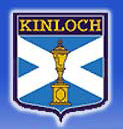By Jeffrey A. Rendall, Photos By Kevin Gaydosh and Jeffrey A. Rendall
|
|
MANAKIN-SABOT, VA -- Kinloch Golf Club's been called the 'Augusta National' of Virginia.
Most folks, when talking about golf courses, categorize layouts in different ways. But somehow, it usually comes down to comparing them (at least the 'great' ones) to legendary golf courses -- something all golf aficionados can latch onto. For example, a links-style course might be compared to a Scottish layout like St. Andrews. Or a seaside course might be compared to Pebble Beach. Or a course with 'turtle shell' greens might be compared to Pinehurst #2. And although it's safe to say most who make the comparisons have never seen the more famous golf links they're referring to (except maybe on TV), the associations keep coming nonetheless.
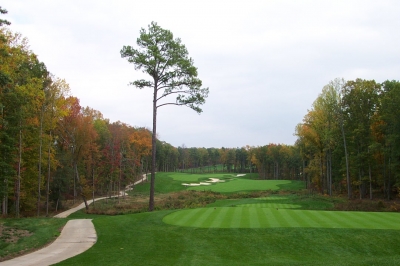 |
| After a relatively straightforward 1st hole, the view from the 2nd tee will give you several different options. |
Who can blame them? For those who've laid eyes on Kinloch Golf Club, they're probably searching for ways to describe what must seem like the closest thing to golfing heaven they will ever witness in a lifetime. It's got the lakeside location of Robert Trent Jones Golf Club (in Gainesville, VA, site of three President's Cup competitions), the tree lined, rolling nature of Augusta National (as seen every April), the traditional, land-hugging quality of Pine Valley (in New Jersey, and often cited as the United States' top course) and the most exceptional playing conditions anywhere.
No wonder people say it reminds them of Augusta National -- personal knowledge notwithstanding.
Kinloch is a product of the collective vision of three men, CB Robertson, Marvin 'Vinny' Giles and Lester George. Robertson owned the land, Giles had the 'name' and championship golfing pedigree (United States Amateur Champion in 1972), and George carried the architectural/technical know-how. Together, they possessed the necessary chemistry to 'dream up' a legend.
It's only appropriate to let the visionaries tell their story: "CB Robertson came to me in 1996, and asked me if I'd build a golf course for him on some land that was owned by his family," Giles commented.
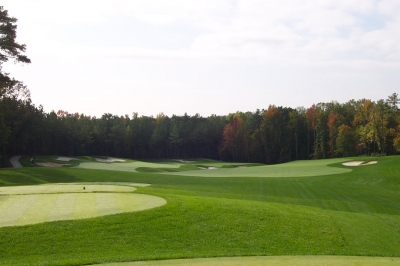 |
| The 334 yard, par four 4th hole is the first of several excellent short par fours at Kinloch Golf Club. Left is the more difficult shot, but will provide an easier approach to the green. |
"And I said, "No I wouldn't," because I didn't have a clue about how to build a golf course. I probably could get from Point A to Point B alright, and I could read a topo map, but I didn't know anything about the finer points of creating a course, like drainage, irrigation, etc."
"But I said I would be very interested in doing something if he'd let me bring in somebody to work with, and that's when I contacted Lester. I brought in Lester because I thought he had a world of talent in the field of design -- and perhaps just as important, he was someone I knew I could work with," Giles added.
Initial thinking on the project was to build an upscale daily fee course. At the time, the Richmond area was one of the most underserved public golf markets in the United States (according to one golf publication, it ranked near the bottom of 300 municipalities -- but has opened several excellent new public courses in recent years), so the need was certainly there. Shortly into the process, however, the vision changed.
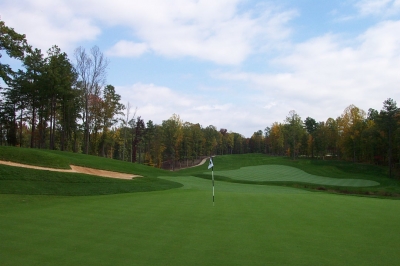 |
| The view from behind the #1 handicap 6th hole only hints at the hole's challenges. |
Giles continues, "We got it cleared and routed, and I was just walking out there by myself one afternoon, and I thought, 'This is pretty special.' And I went back to CB, and I told him, "You just don't find places like this very often -- would you consider, what I might deem a stupid financial move -- would you consider making it a pure golf club?""
"And, I think because, one, he was interested in having a quality product, and two, because he is developing real estate on the back end of the property, he agreed to do that. So that's how Kinloch got started, and obviously the vision changed dramatically. The 'new' plan was to really go all out and create 18, and in this case, 19, quality golf holes -- with the idea that it would be a pure golf club, and that's what we did," Giles added.
There's no exaggeration in that statement. Kinloch does have the inexpressible quality Giles was talking about, and it also contains the 19 holes he mentioned -- the 19th hole being a 172 yard par three that's utilized to 'settle up' tied matches at the end of the day, and also provides dramatic theater for members enjoying the sights from the clubhouse deck, which overlooks the 19th green and the lake.
George says it was his idea to create the additional hole: "The 19th hole was really more of constraint situation, where we had to come back across the dam (editor's note: there's a bit of distance between the 18th green and the clubhouse -- you have to travel around the lake to reach the finishing area), and the peninsula was just sitting there."
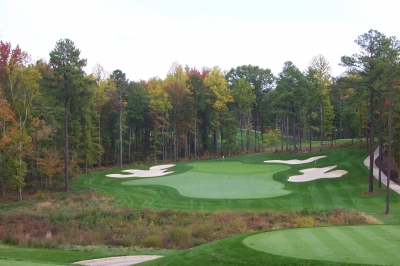 |
| Looking down at the 237 yard, par three 7th hole, you'll notice there's a large target to shoot at. What's not apparent is how severe the green is. |
"The more we talked about it, the more we liked the idea of creating a 19th hole, for settling bets and having a 'bye' hole. It was basically giving people something to look forward to, rather than just the trip across the dam," George said.
It's also perhaps another allusion to the legendary 'Masters' course: "It was after deciding to build it that we discovered Augusta National originally had a 19th hole planned, but was never built, and many other clubs have had them, too. We certainly weren't the first," George admitted.
Kinloch's 19th hole may not have been a first, but there were plenty of unique things to go 'round at the club. Perhaps first and foremost was its surprising ease in creation. George elaborates: "As soon as we'd finished the routing on the maps and cut the center lines on the property, we walked the entire course to see what we had. I think we made one change to the routing that day, and it never changed again. Even after clearing, after we saw everything we needed to see, we never moved a green, never moved a tee, nothing. The course just fit that naturally onto the land. It was truly amazing."
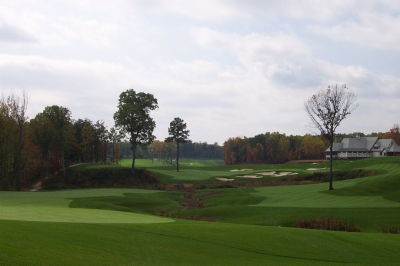 |
| The 556 yard, par five 9th hole. Enough said. |
Because the course fit so well, they didn't alter the land much. Both Giles and George are extremely proud of the fact not much earth was moved: "We only moved about 180,000 yards cubic yards of dirt on nineteen holes and a driving range, which is unheard of nowadays. If you think about it, that's less than 10,000 yards a hole, which is basically just tees and greens. We knew we had a special piece of ground, and didn't want to alter it too much -- we wanted a very traditional layout that just looks like it's been there forever, George said.
Giles concurs with George: "It seems these days, when these guys build golf courses, they have to move a million yards to justify their existence. it's ridiculous, but that's the new modern trend. We didn't want that at Kinloch."
The reason being, everyone involved wanted the club to be as traditional as possible, including its name and 'heritage.' Phil Owenby, Kinloch's Director of Golf, tells the tale behind it: "When the decision was made to make Kinloch a private golf club, they wanted it to have a Scottish flavor and give it a Scottish moniker. So, Vinny, Lester and CB started looking at possible names (between three and four hundred total). When they saw 'Kinloch,' they liked it because it was rather simple, classy and traditional, but more important, it means near, or 'kin' to a body of water in Scottish. So it obviously fits."
The Scottish connection is more than just the name. "Our Coat of Arms has the St. Andrews cross, and the St. Andrews colors of royal blue and white. Then we have Mr. Giles' US Amateur trophy on it, and it's in the shape of a shield, which all the Scottish clubs have for their logos. Believe me, a lot of thought went into every aspect of this club," Owenby adds.
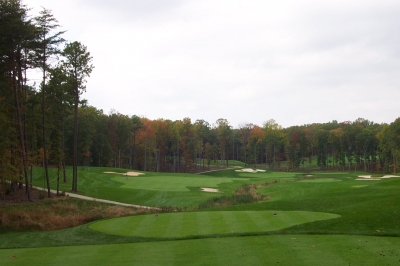 |
| Tee box views from the 495 yard, par five 11th hole -- several more options, but you better try the more difficult left side if you want to go at the green in two. |
According to Owenby, playing conditions are another way Kinloch sets itself apart from the rest: "You can't say enough about the course conditions at our club. Superintendent Pete Wendt deserves all the credit in the world for maintaining the golf course. Most people say about course conditions -- that they'll be better in the fall, or the spring. But our course looks this good all-year round."
"The fairways are kept tight, but they're spongy and very easy to hit any club off of them. And the greens -- although fast, and they're going to remain fast -- they're so true. If the ball is on-line, it's going to stay right there, on-line, and you can make putts up to 40-50 feet just by getting 'em on-line. It never wavers -- the ball just rolls so smoothly on those greens. That's one of the player-friendly things about our club -- you'll find near perfect conditions whenever you come here," Owenby proudly proclaimed.
Eyesight doesn't lie, and just by looking at the course you'll realize that just about every blade of grass cooperates with the 'vision.' But there's another story behind the rolling waves of green at Kinloch. The greenery actually originated elsewhere, in Delaware.
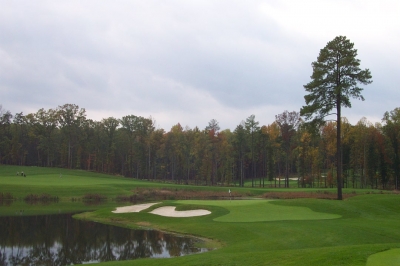 |
| At 152 yards, the par three 14th hole is the shortest on the course, but the green's also a small target. |
"People are often amazed when they hear about how economically Kinloch was built. A large part of that was because we didn't move much dirt, but saving money in that respect allowed us to devote resources to other areas, like laying sod on virtually the entire course, George said.
"It's the furthest course south that has bentgrass fairways and bluegrass roughs. After we made the decision to go with those surfaces, which no one else had ever attempted in this region -- we went out and contract grew 120 acres of short-mowed bluegrass rough, and 40 acres of L93 bentgrass sod for the fairways. Bill Kubly of Landscapes Unlimited (Kinloch's course construction contractor) told me he's never seen anybody sod an entire golf course, both the fairways and the rough. Kinloch is probably the only existing course that was done that way," George mused.
As Owenby said above, every aspect of the club was thoroughly planned out and mulled over, and that's never more evident than when examining Kinloch's practice facilities. He says, "Our practice facilities are world-class. It's something that took a lot of time, energy and thought to build, and I think our members realize they can come out and spend three hours out there and never really practice the same phase of the game twice."
Much effort was devoted towards simulating actual on-course situations. Most high-end clubs have practice bunkers, grass tees, chipping greens, putting greens and year-round facilities providing video swing analysis and instruction. Kinloch's got all of those, including a range that's maintained to actual course conditions (including the target greens), and a pitching/chipping area that's large enough to hit full lob wedge shots (up to 70 yards) on. Finally, the putting green is enormous.
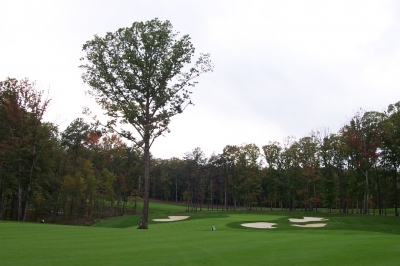 |
| The par four 15th hole (328 yards) is just one of several holes where trees figure prominently, providing different ways to play the hole. |
"They've (Giles & George) created on-course situations, so you feel like you're practicing out on the golf course," Owenby said.
You'll use those shots out on the layout, too. Though very friendly off the tee, you'll need precise accuracy to hit the right spots on fairways, in order to leave higher percentage shots into the greens. And often, there are several choices on how to approach a hole.
The ultimate signature hole, number nine, is a perfect example. 556 yards from the back tee, it's a dogleg right par five, potentially reachable in two, depending on several choices presented on the tee and second shots. George said the hole's brilliance wasn't immediately apparent, even to Giles: "We cut the centerline of the hole, and I'm out there in the woods with Vinny, and we're standing in the tee shot landing area. I've got a flight line going to the right, I've got a flight line going straight at the green, and another alternate flight line going up to the left and over the top. He said, "Lester, I just don't get it, I don't understand it, and I'm never going to understand it.""
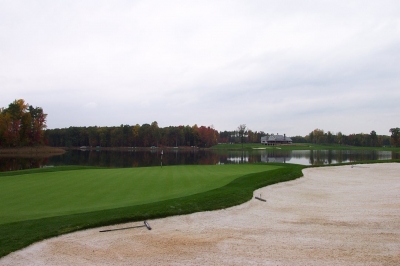 |
| When you reach the 18th green, glance across the lake towards the clubhouse and the 19th hole. You'll definitely regret the round's almost over. |
He eventually did get it, and according to George, Giles' influence on the course was invaluable and wide-reaching. George said Giles' vast knowledge of different golf shots and how to play the game helped create the incredible variety of shot values on the course.
And for his part, Giles said, "Consulting on Kinloch's golf course is probably the most fun I've ever had in the game of golf." A pretty heady endorsement from a man who's won a US Amateur championship, and represented (in an agent capacity) several other championship caliber players.
But Kinloch Golf Club really is that impressive. It's got everything a golfer would dream of in a golf club, and more. So much so, that someday they might be calling some brand new golf course in some yet-to-be-determined location the 'Kinloch' of that state.
Note: Kinloch Golf Club was named 'Best New Private Course' for 2001 by Golf Digest.
Details:
Kinloch Golf Club
1100 Hockett Road
Manakin-Sabot, VA 23103
Phone: (804) 784-8000
FAX: (804) 784-8717
Website: www.kinlochgolfclub.com
Course Designers: Lester George & Marvin ‘Vinny’ Giles
Director of Golf: Phil Owenby
Kinloch’s Owners: CB Robertson, Marvin ‘Vinny’ Giles & Charles Staples*
Head Golf Professional: Jonathan Ireland
Golf Course Superintendent: Peter Wendt
*Editor’s Note: Charles Staples was asked to join the ownership group early on, after the decision to convert the property to a golf club -- and Mr. Staples actually brought the concept of the Golf Club to the other two owners. He has been instrumental and responsible for the business plan, operations and success of Kinloch Golf Club.
| Tees | Yardage/Slope | Rating |
| Championship | 7112/138 | 75.0 |
| Back | 6671/137 | 72.9 |
| Middle | 6186/134 | 70.2 |
| Forward | 5360/131 | 71.1 |
Membership Information:
For membership and corporate or charity outing information: Contact Phil Owenby at (804) 784-8000. Membership is by invitation only.
| Related Links | Comments on this article? | |
|
Maryland National Golf Club Hollow Creek Golf Club Rocky Gap Resort PB Dye Golf Club in Ijamsville Whiskey Creek Golf Club |
E-mail Jeff Rendall, Editor: jrendall@golftheunitedstates.com |

